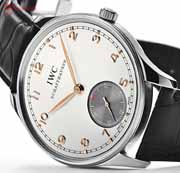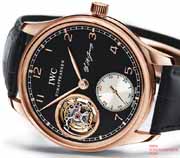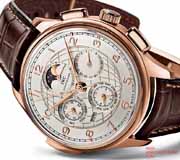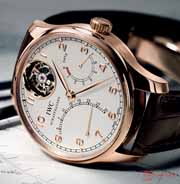

IWC
Les nouveautés 2010 des montres IWC (On en parle sur le forum)
Portugaise Yacht Club Chronographe
Ses spécificités en matière de technique horlogère en font la compagne idéale de ceux qui pratiquent la voile sportive: grâce à son mouvement manufacturé IWC calibre 89360, elle est dotée d’un mouvement de chronographe des plus modernes et des plus robustes – avec fonction «flyback» (retour en vol) et indicateur analogique des longs temps d’arrêt par le biais de deux aiguilles sises dans un cadran interne.
Etanche jusqu’à 6 bar, c’est le seul modèle de Portugaise qui comporte des aiguilles et des index lumineux dans l’obscurité; cette montre constitue un chronographe parfait de par son large cadran très lisible.
Elle existe en acier avec cadran noir ou argenté ainsi qu’en or rouge avec cadran ardoise et compteurs noirs.
It has been upgraded technically to make it the perfect companion for navigation and sailing: in the IWC-manufactured 89360-calibre movement, it has one of the most modern and robust chronograph movements on board – with a flyback function and analogue display of the long stop times via two hands on an inner dial.
It is water-resistant to 6 bar and is the only Portuguese to have luminous hands and indices. Its large, clear dial makes it a perfect chronograph.
It is available in steel with a black or silver-plated dial and in red gold with a slate-coloured dial and black registers.
Portugaise Remontage Manuel
La Portugaise Remontage Manuel en acier fin à cadran noir, chiffres arabes rhodiés et aiguilles feuilles caractéristiques se distingue par son cercle des secondes argenté qui comporte un détail sortant de l’ordinaire: un «60» rouge vif.
Le modèle-soeur, à cadran argenté avec des indices et des aiguilles plaqués or rose, se différencie par son cercle des secondes gris clair faisant ressortir un petit «60» rouge.
Les deux modèles sont dotés d’une minuterie typique de forme classique «chemin de fer» et d’un calibre de manufacture 98295 avec des références stylistiques aux premiers mouvements Jones, telles que le pont trois quarts platine en maillechort et la raquette surdimensionnée permettant le réglage précis de la longueur active du spiral.
The Portuguese Hand-Wound in stainless steel with a black dial, rhodium-plated Arabic numerals and the characteristic feuille hands is conspicuous by its silver-plated seconds subdial with the distinctive detail of a “60” in signal red.
Its sibling model with a silver-plated dial and rose gold-plated indices and hands stands out with its seconds subdial in light grey, also with a small red “60”.
Features common to both are the typical chapter ring in the traditional railwaytrack style and, as the drive mechanism, the IWC-manufactured 98295 calibre with stylistic echoes of the first Jones movements, such as the nickel-silver three-quarter bridge and the elongated index to facilitate precision adjustment of the effective length of the spring.
Portugaise Tourbillon Remontage Manuel
La Portugaise Tourbillon Remontage Manuel fait référence à la tradition aussi en ce qui concerne la technique horlogère. A travers le fond en verre saphir, on peut admirer le mouvement de manufacture IWC calibre 98900.
Il est issu d’une longue lignée de mouvements de montres de poche réputés de la Manufacture de Schaffhausen qui conviennent particulièrement bien aux grandes montres bracelets à remontage manuel. Les premières Portugaise de la fin des années 30 étaient déjà dotées de mouvements de montre de poche.
En se fondant sur la famille des calibres 98000, fabriqués depuis les années 20 et constamment adaptés aux progrès techniques, l’on marie aujourd’hui tradition et derniers acquis de la technique horlogère.
La pont trois quarts platine finement décorée en maillechort nickelé suit le principe de fabrication des calibres Jones d’autrefois. Son pendant optique est constitué du pont pour le tourbillon minutes, fixé au moyen d’un médaillon en or (Probus Scafusia).
En ce qui concerne les impulsions, la fréquence des oscillations du balancier a été augmentée de 18 000 à 28 000 alternances/ heure
The allusion to continuing tradition is also embodied in the watchmaking technology of the Portuguese Tourbillon Hand-Wound. The mechanical IWC-manufactured 98900-calibre movement can be observed through the seethrough sapphire-glass back. It lies at the top of a long ancestral line of famous pocket watch movements from the Schaffhausen manufacturer and is ideally suited for large wristwatches with hand winding.
The first Portuguese watches dating from the late 1930s were already equipped with pocket watch movements. Based on the 98000-calibre family that has been built and nurtured since the 1920s, it now combines tradition with the latest watchmaking advances.
The finely decorated nickel-silver three-quarter bridge evokes the design principle of the earliest Jones calibres. Its visual counterpart is the bridge for the minute tourbillon provided with a gold medallion (Probus Scafusia).
The balance frequency of this drive mechanism has been increased from 18,000 to 28,800 beats per hour.
Portugaise Grande Complication
La Portugaise Grande Complication, pour laquelle un nouveau boîtier d’un diamètre de 45 millimètres a été créé, est dotée de fonctions hors du commun: le calibre chronographe 79091 à remontage automatique avec mesure du temps additionnel allant jusqu’à 12 heures, la répétition minutes qui avait été conçue spécialement pour le modèle de jadis et qui fait partie des mécanismes les plus modernes et fiables du genre ainsi que – enfin et surtout – un calendrier perpétuel autonome.
L’utilisateur dispose ainsi – et c’est une prouesse encore aujourd’hui inégalée – non seulement de la date, du jour de la semaine, du mois, mais aussi de l’année, de la décade, du siècle et du millénaire par le biais d’un affichage à quatre chiffres.
Le calendrier ne nécessite ni correction ni intervention de la part de l’utilisateur jusqu’à l’année 2100 puisqu’il programme mécaniquement puis assure ensuite la constante synchronisation de toutes les indications.
The Portuguese Grande Complication, for which a new case with a diameter of 45 millimetres has been created, inherits an extraordinarily wellproven technical inventory: the 79091-calibre chronograph movement with automatic winding and aggregate time recording up to 12 hours, the minute repeater – a complication specially constructed at the time – which belongs to the most modern and reliable mechanisms of its kind and, last but not least, the autonomous perpetual calendar.
It also shows the wearer the year, decade, century and millennium in a four-digit display, as well as the day, date and month, in a way that is unsurpassed to this day.
A perpetual moon phase display, with a deviation of only a single day in 122 years from the actual cycle of the moon, is connected to the calendar, which requires no adjustments or interventions on the part of the wearer until the year 2100 and advances all the calendar indications in a mechanically programmed and synchronous manner.
Portugaise Tourbillon Mystère Rétrograde
La surface du cadran aux dimensions généreuses a été élargie de près d’un quart pour que l’on puisse y insérer l’affichage rétrograde de la date, qui a été intégré au calibre de manufacture 51900.
A la fin des mois de 31 jours (janvier, mars, mai, juillet, août, octobre et décembre), l’indicateur de la date revient automatiquement sur le chiffre «1».
A la fin des mois plus courts, un système de commutation rapide permet, même si la montre n’a pas été portée pendant un certain temps, de faire avancer le disque de la date jusqu’au premier du mois.
Ainsi, il n’est pas nécessaire de dérégler l’heure… Un apport qui confère à cette noble montre un affichage de la date hors du commun.
La petite seconde, qui était auparavant située là où se trouve maintenant le guichet de la date, a été avantageusement remplacée par un tourbillon minutes: en effet, c’est cette petite cage d’acier, avec ses trois brides caractéristiques en forme d’étoile, qui assume désormais cette fonction.
Sur la moitié droite du cadran, l’indication de la réserve de marche de sept jours informe de l’énergie restante du barillet, énergie fournie de manière très efficiente par le mécanisme de remontage Pellaton à toute épreuve, dont est dotée cette famille de calibres.
The graduated scale for the supplementary flyback date indicator, which is integrated into the IWC-manufactured 51900-calibre movement, extends over one quarter of the surface of the generously dimensioned dial. On reaching the end of any months with 31 days – January, March, May, July, August, October, December – the date indicator springs back automatically to “1”.
In shorter months, or also if the watch has not been worn for some time, the date indicator can be advanced by the rapid adjustment function and flies back to the first day of the month. The time does not need to be adjusted in conjunction with this.
This superior watch is now enhanced by an exceptional display. The small seconds, which previously occupied this position, is replaced in a particularly appealing fashion by the minute tourbillon. Its steel cage with the three characteristic stays arranged in the shape of a star performs this function. On the right half of the dial, the indicator for the seven-day power reserve displays information about the remaining available power of the spring barrel, which is supplied to it in a highly efficient manner via the proven Pellaton winding system of this calibre family.




